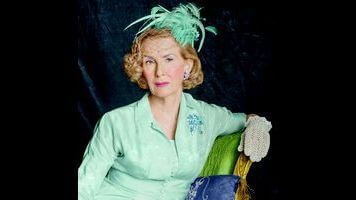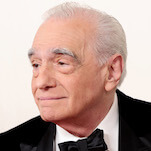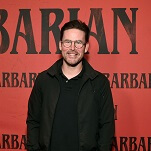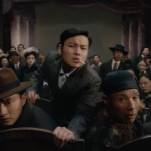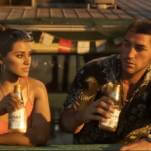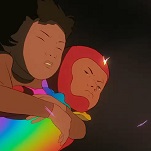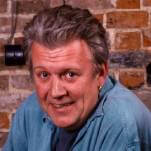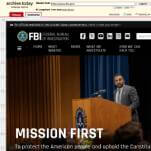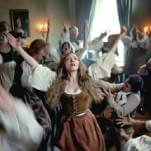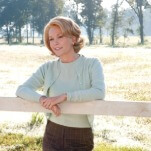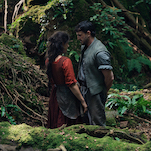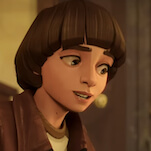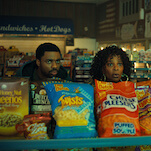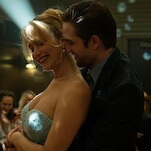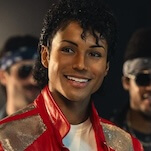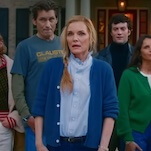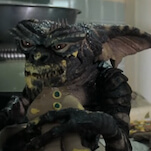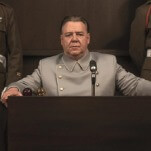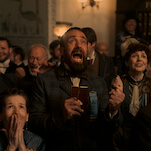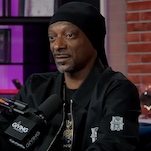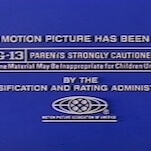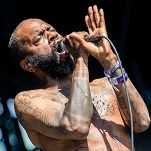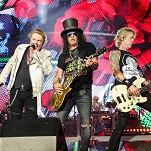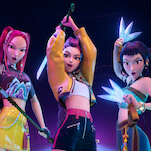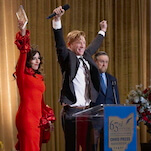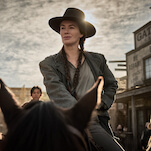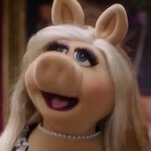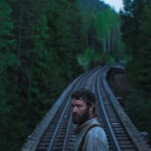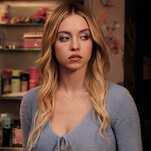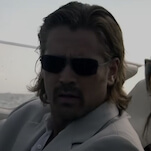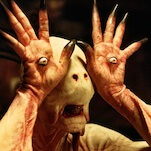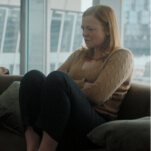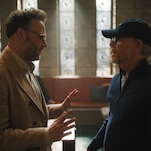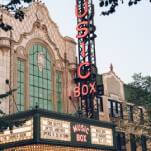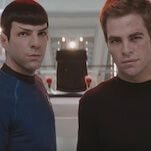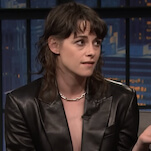The latest installment of American Horror Story: Freak Show is all tied up in easy circus metaphors: The spinning wheel Elsa unearths is both fate and trust in an eye-catching candy-cane color scheme. The episode makes itself so busy, however, it reminded me of another bit of three-ring imagery. It’s common for a show like American Horror Story to be spoken of like a juggling act, its many stories and characters and themes becoming the balls the show keeps in the air. But American Horror Story prefers something flashier, something with a little bit more danger. This show juggles chainsaws, attempting to keep multiple risky moves aloft, any number of which could fall from the sky and maim an episode like “Bullseye.”
When “Bullseye” drops a chainsaw, it loses a pinky toe at most. This is the episode that’s been waiting to fight its way out of Freak Show all along, catalyzing the season’s potential energy into the genuine spectacle of histrionic freakouts and hypnogogic fantasy. The novelty of the fourth season’s molasses pacing has worn off without compelling stories to prop it up or big chills to vary the dynamics, and after some lackluster attempts at something new, “Bullseye” celebrates Elsa’s birthday with the gift of things American Horror Story is good at: Unhinged camp, lush visuals, and the loudest emotions Jessica Lange can muster.
She needs those emotions, because she’s finally served—along with Flintstones movie-star parody Finn Wittrock—the big, juicy scenery steaks she’s been ready for since episode one. Wolfing down the damn thing in four or five bites beneath Fraulein Elsa’s big top, Lange releases the sideshow megalomaniac she’s suppressed for the past five weeks. These are pivotal moments for her character, demonstrating the monstrous extremes of her Hollywood fantasy, a fantasy for which she willingly sacrifices a lover and a family member she prefers to call “monster.” Lots of people have fantasies in “Bullseye,” most of which involve murder and mayhem—but only Elsa’s manages to shed any blood. Is it any wonder this King Joffrey of the carnival circuit receives birthday presents in her own, feathery version of the Iron Throne?
Sharing more in common with Joffrey—homicidal impatience, for instance, and a dash of inbreeding—Dandy is also treated well by “Bullseye.” Clear-cut villains are welcome after Esmerelda reconsiders her reasons for being in Jupiter (and boy was that reconsideration ever quick); they’re especially welcome among the saturated colors of the Mott estate. The production design in these scenes delineates the family’s largesse from the rustic environs of the freak show (outside of Elsa’s tent, that is) with a heavy hand, and all the splashes of red might as well come with individual blood types. But I can’t help but prefer scenes with Dandy, Gloria, and their new house guests, the Tattler twins, because there’s so much more purpose and life to them. An equal amount of investment must’ve gone into the look of Fraulein Elsa’s Cabinet Of Curiosities, but characters who only wear one or two outfits (and don’t progressively cake those outfits in mud and shit like the residents of Deadwood) run the risk of turning into visual static—realism be damned.
Mourning suits the Motts, as do the corresponding angel/devil headbands bestowed upon Dot and Bette. Trapped in the creepiest game of house ever filmed, the twins help Dandy check Annie Wilkes off of his Famous Psychos Of Hollywood checklist—and with the froggy Ted Levine notes Finn Wittrock hits during his soliloquy about plants in the desert, “Bullseye” pulls in Buffalo Bill for a pop-culture killer twofer. Sarah Paulson’s two-headed getup makes for a clever addition to Freak Show’s “on display” motif, blending naturally with the symmetrical composition of the mansion. In the home of a self-declared messenger of chaos, there is order. The Motts have discovered the hard way that order is impossible to maintain; Dot, meanwhile, dreams similarly of conquering nature (and disposing of her sister in the process).
The straight-up dramatics of “Bullseye” are rich, though the dramatic irony of the episode is slack. Even before it’s revealed that the twins are in Dandy’s custody (and even then, the last scene of “Pink Cupcakes” more or gave that away) there’s not much that’s mysterious about the mystery of Dot and Bette’s disappearance. Sharing such information with the audience but keeping the characters in the dark just doesn’t hold much tension, and it doesn’t help that we only know how much Dot and Bette meant to their fellow performers because those fellow performers keep saying so. It undercuts Elsa’s jealousy ever so slightly: We’ve witnessed the difference between the crowd reactions to “Life On Mars?” and “Criminal,” but all of the other characters are so far off in their own worlds that you can’t get a feeling out of them if it’s not expressed in a monologue. Watching American Horror Story means accepting this basic fact about the show: Freak Show can include all of the talky, breeze-shooting scenes it wants, but that’s not going to help when that breeze is bullshit like Elsa’s story about her dead sister. The show gains so much from big, broad performance because a) it’s fun, and b) Jessica Lange’s lung capacity distracts from the fact that she’s not playing a character so much as she’s playing verbatim transcripts from the Freak Show show bible.
And yet, beneath the din of the fireworks, Mat Fraser manages to sneak some nuance into “Bullseye.” Paul’s love triangle allows Fraser to do some poignant, human-sized work, even as that work pulls Grace Gummer back into an ensemble that could withstand a few more slayings. (Dell and Desiree have fallen off the face of the Earth again, which is fine because there’s absolutely no room for them in this expanded episode.) Fraser plays these notes well, probably because, as he expressed in his interview with The A.V. Club, they’re an all-too-rare chance to play his “universal humanity.” If nothing else, “Bullseye” is a nice spotlight episode for the actor and his character, even as it sets him up to be the escape hatch for the latest character who wants to ditch polite society and run away with the circus.
That circus could certainly stand to be more interesting—maybe Elsa’s birthday wish will backfire next week? I’m guessing that the actors’ availabilities factored in heavily here, but the scenes in and around the freak show feel oddly sectioned off from one another. Stanley and Esmerelda practically inhabit their own parallel universe in “Bullseye,” which raises the nitpicking question: How can we tell that they’re building up enough trust with their potential victims? Theirs is one chainsaw that Freak Show doesn’t know what to do with. But “Bullseye” does such great work with some of its other chainsaws, you can easily pay attention to what’s staying in the air and not worry too much about Stanley and Esmerelda. It’s unclear whether or not anyone involved with the show cared all that much about any of the characters, really.
Stray observations:
- A big thanks to last week’s substitute reviewer, Emily L. Stephens. She took on the full force of that “Fame” montage, and for that I am eternally grateful.
- This week’s proposed American Horror Story spin-off: Pathetic Baby Pickaxe, a prequel depicting Toulouse’s time on the chain gang. (Theme song by The Pretenders.)
- Artist’s rendering of Ma Petite’s made-up formaldehyde bath:
- We’re passing the midway point of the fourth season, and I’m itchy to call shenanigans on the the idea that once these characters are dead, they stay dead. That seems like a hard standard to live up to, considering that none of the characters are dying (outside of fantasy sequences).
- I would’ve thought the Motts had more discerning taste when it comes to soda: “Dandy, I brought you snackies! Ihave RC Cola, too.”
